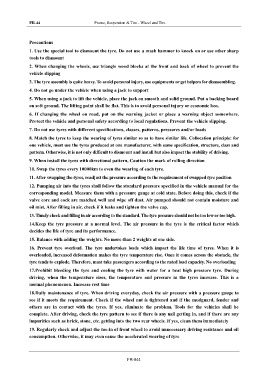Page 1044 - Foton Workshop Manual - Auman EST-M
P. 1044
FR-44 Frame, Suspension & Tire - Wheel and Tire
Precautions
1. Use the special tool to dismount the tyre. Do not use a mash hammer to knock on or use other sharp
tools to dismount
2. When changing the wheels, use triangle wood blocks at the front and back of wheel to prevent the
vehicle slipping
3. The tyre assembly is quite heavy. To avoid personal injury, use equipments or get helpers for disassembling.
4. Do not go under the vehicle when using a jack to support
5. When using a jack to lift the vehicle, place the jack on smooth and solid ground. Put a backing board
on soft ground. The lifting point shall be flat. This is to avoid personal injury or economic loss.
6. If changing the wheel on road, put on the warning jacket or place a warning object somewhere.
Protect the vehicle and personal safety according to local regulations. Prevent the vehicle slipping.
7. Do not use tyres with different specifications, classes, patterns, pressures and/or loads
8. Match the tyres to keep the wearing of tyres similar so as to have similar life. Collocation principle: for
one vehicle, must use the tyres produced at one manufacturer, with same specification, structure, class and
pattern. Otherwise, it is not only difficult to dismount and install but also impact the stability of driving.
9. When install the tyres with directional pattern, Caution the mark of rolling direction
10. Swap the tyres every 10000km to even the wearing of each tyre.
11. After swapping the tyres, readjust the pressure according to the requirement of swapped tyre position
12. Pumping air into the tyres shall follow the standard pressure specified in the vehicle manual for the
corresponding model. Measure them with a pressure gauge at cold state. Before doing this, check if the
valve core and cock are matched well and wipe off dust. Air pumped should not contain moisture and
oil mist. After filling in air, check if it leaks and tighten the valve cap.
13. Timely check and filling in air according to the standard. The tyre pressure should not be too low or too high.
14.Keep the tyre pressure at a normal level. The air pressure in the tyre is the critical factor which
decides the life of tyre and its performance.
15. Balance with adding the weights. No more than 2 weights at one side.
16. Prevent tyre overload. The tyre undertakes loads which impact the life time of tyres. When it is
overloaded, increased deformation makes the tyre temperature rise. Once it comes across the obstacle, the
tyre tends to explode. Therefore, must take passengers according to the rated load capacity. No overloading
17.Prohibit bleeding the tyre and cooling the tyre with water for a heat high pressure tyre. During
driving, when the temperature rises, the temperature and pressure in the tyres increase. This is a
normal phenomenon. Increase rest time
18.Daily maintenance of tyre. When driving everyday, check the air pressure with a pressure gauge to
see if it meets the requirement. Check if the wheel nut is tightened and if the mudguard, fender and
others are in contact with the tyres. If yes, eliminate the problem. Tools for the vehicles shall be
complete. After driving, check the tyre pattern to see if there is any nail getting in, and if there are any
impurities such as brick, stone, etc. getting into the two rear wheels. If yes, clean them immediately
19. Regularly check and adjust the toe-in of front wheel to avoid unnecessary driving resistance and oil
consumption. Otherwise, it may even cause the accelerated wearing of tyre
FR-044

